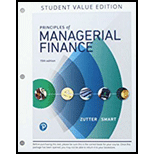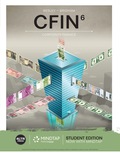
Principles of Managerial Finance, Student Value Edition Plus MyLab Finance with Pearson eText - Access Card Package (15th Edition) (Pearson Series in Finance)
15th Edition
ISBN: 9780134830209
Author: Chad J. Zutter, Scott B. Smart
Publisher: PEARSON
expand_more
expand_more
format_list_bulleted
Question
Chapter 4, Problem 4.4WUE
Summary Introduction
To calculate:
Introduction:
Cash flow is the inflow and outflow of cash and capital in a business where, a positive cash flow implies rise in the liquid assets, return on capital to the shareholders and more whereas a negative cash flow includes decreasing in the firm’s liquid assets.
The free cash flow indicates whether the company has adequate cash flow to cover both the operating as well as the fixed and current assets investments.
Expert Solution & Answer
Want to see the full answer?
Check out a sample textbook solution
Students have asked these similar questions
Don't use ChatGPT!!
A company has a profit margin of 14 percent on sales of $35,000,000. If the company has total assets of $29,500,000, and an after-tax interest cost on total debt of 4.2 percent, what is the company's ROA? a. 12.91% b. 19.41% C. 12.01% d. 16.61% e. 15.11%
I need help in this question!
Don't use ChatGPT!!
A company has a profit margin of 14 percent on sales of $35,000,000. If the company has total assets of $29,500,000, and an after-tax interest cost on total debt of 4.2 percent, what is the company's ROA? a. 12.91% b. 19.41% C. 12.01% d. 16.61% e. 15.11%
Don't use AI tool!!
A company has a profit margin of 14 percent on sales of $35,000,000. If the company has total assets of $29,500,000, and an after-tax interest cost on total debt of 4.2 percent, what is the company's ROA? a. 12.91% b. 19.41% C. 12.01% d. 16.61% e. 15.11%
Chapter 4 Solutions
Principles of Managerial Finance, Student Value Edition Plus MyLab Finance with Pearson eText - Access Card Package (15th Edition) (Pearson Series in Finance)
Ch. 4.1 - Prob. 4.1RQCh. 4.1 - Prob. 4.2RQCh. 4.2 - Briefly describe the first four modified...Ch. 4.2 - Describe the overall cash flow through the firm in...Ch. 4.2 - Prob. 4.5RQCh. 4.2 - 4-B Why is depreciation (as well as amortization...Ch. 4.2 - Prob. 4.7RQCh. 4.2 - Prob. 4.8RQCh. 4.2 - Prob. 4.9RQCh. 4.3 - Prob. 4.10RQ
Ch. 4.3 - Prob. 4.11RQCh. 4.3 - Prob. 4.12RQCh. 4.3 - What is the cause of uncertainty in the cash...Ch. 4.4 - Prob. 4.14RQCh. 4.5 - Prob. 4.15RQCh. 4.5 - Prob. 4.16RQCh. 4.6 - Prob. 4.17RQCh. 4.6 - What is the significance of the plug figure,...Ch. 4.7 - Prob. 4.19RQCh. 4.7 - Prob. 4.20RQCh. 4 - Opener-in-Review The chapter opener described a...Ch. 4 - Learning Goals 2, 3 ST4-1 Depreciation and cash...Ch. 4 - Prob. 4.2STPCh. 4 - Prob. 4.3STPCh. 4 - Prob. 4.1WUECh. 4 - Prob. 4.2WUECh. 4 - Learning Goal 3 E4-3 Determine the operating cash...Ch. 4 - Prob. 4.4WUECh. 4 - Learning Goal 5 E4-5 Rimier Corp. forecasts sales...Ch. 4 - Prob. 4.1PCh. 4 - Learning Goal 2 P4-2 Depreciation In early 2019,...Ch. 4 - Prob. 4.3PCh. 4 - Learning Goals 2, 3 P4-4 Depreciation and...Ch. 4 - Learning Goal 3 P4-5 Classifying inflows and...Ch. 4 - Prob. 4.6PCh. 4 - Learning Goal 4 P4-8 Cash receipts A firm has...Ch. 4 - Learning Goal 4 P4-9 Cash disbursements schedule...Ch. 4 - Learning Goal 4 P4-10 Cash budget: Basic Grenoble...Ch. 4 - Prob. 4.11PCh. 4 - Learning Goal 4 P4-12 Cash budget: Advanced The...Ch. 4 - Prob. 4.13PCh. 4 - Prob. 4.14PCh. 4 - Learning Goal 4 P4-15 Multiple cash budgets:...Ch. 4 - Learning Goal 5 P4-16 Pro forma income statement...Ch. 4 - Learning Goal 5 P4-17 Pro forma income statement:...Ch. 4 - Learning Goal 5 P4-18 Pro forma balance sheet:...Ch. 4 - Learning Goal 5 P4-19 Pro forma balance sheet...Ch. 4 - Learning Goal 5 P4-20 Integrative: Pro forma...Ch. 4 - Learning Goal 5 P4-21 Integrative: Pro forma...Ch. 4 - Prob. 4.22PCh. 4 - Prob. 1SE
Knowledge Booster
Similar questions
- A company has a profit margin of 14 percent on sales of $35,000,000. If the company has total assets of $29,500,000, and an after-tax interest cost on total debt of 4.2 percent, what is the company's ROA? a. 12.91% b. 19.41% C. 12.01% d. 16.61% e. 15.11%arrow_forwardWhat does the term "liquidity" refer to in finance?a) A company's profitabilityb) Ease of converting an asset into cashc) Stability of cash flowsd) Amount of debtsarrow_forwardCan you provide correct answer? What is the primary goal of financial management? A) Maximizing revenuesB) Minimizing costsC) Maximizing shareholder wealthD) Increasing market sharearrow_forward
- Can you provide correct answer? The time value of money concept assumes that: A) A dollar today is worth more than a dollar in the futureB) A dollar in the future is worth more than a dollar todayC) Money loses value only when interest rates riseD) Money value remains constant over timearrow_forwardCan you answer this question? Which type of bond offers tax advantages? A) Convertible bondsB) Municipal bondsC) Corporate bondsD) Junk bondsarrow_forwardI need help! Which of the following is a source of external finance? A) Retained earningsB) Bank loansC) Sale of assetsD) Cost cuttingarrow_forward
- Diversification in investing reduces which type of risk? A) Market riskB) Systematic riskC) Unsystematic riskD) Liquidity riskarrow_forwardWhich type of bond offers tax advantages? A) Convertible bondsB) Municipal bondsC) Corporate bondsD) Junk bonds help!!arrow_forwardWhich type of bond offers tax advantages? A) Convertible bondsB) Municipal bondsC) Corporate bondsD) Junk bondsexplanation!arrow_forward
- Which type of bond offers tax advantages? A) Convertible bondsB) Municipal bondsC) Corporate bondsD) Junk bondssolutionarrow_forwardThe term 'liquidity' in business refers to:A. The ability to generate profitB. The ease with which an asset can be converted into cashC. The long-term financial stability of a companyD. The amount of debt a company carries need helparrow_forwardNo chatgpt! Which type of bond offers tax advantages? A) Convertible bonds B) Municipal bonds C) Corporate bonds D) Junk bondsarrow_forward
arrow_back_ios
SEE MORE QUESTIONS
arrow_forward_ios
Recommended textbooks for you

